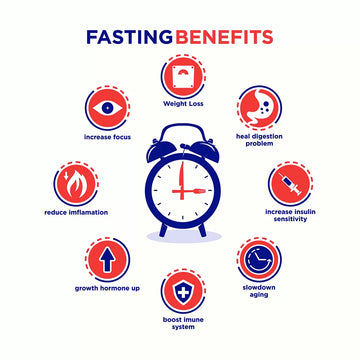Discover Related Products
Now explore supplements designed to support Longevity, Gut Health & Cellular Vitality.
CITOZYM - Support Natural Detox, Immune and Longevity Support
Benefits and Risks of Daily Exercise: Insights Based on Scientific Research

Daily exercise is crucial for maintaining a healthy lifestyle, but how much is too much? This article explores the benefits and potential risks of daily exercise, using scientific evidence to provide a balanced and informed perspective.
Benefits of Daily Exercise
1. Improved Cardiovascular Health
Daily exercise enhances heart function and reduces the risk of cardiovascular diseases. Regular physical activity helps lower blood pressure, improve cholesterol levels, and reduce the risk of heart disease and stroke (1).
2. Weight Control
Daily exercise helps maintain a healthy body weight by increasing calorie expenditure and boosting metabolism. Regular physical activity is essential for weight management and preventing obesity (2).
3. Mental Health Improvement
Regular physical activity is linked to improved mood and reductions in symptoms of depression and anxiety. Exercise stimulates various brain chemicals that may leave you feeling happier, more relaxed, and less anxious (3).
4. Increased Longevity
Research connects daily exercise with increased life expectancy. Even small amounts of physical activity, such as 15 minutes a day, can extend life expectancy compared to inactivity (4).
5. Enhanced Cognitive Function
Studies suggest that daily exercise improves cognitive functions, including memory, especially in older adults. Regular physical activity is one of the best things you can do to reduce your risk of Alzheimer's and other dementias (5).
6. Strengthened Immune System
Regular exercise can strengthen the immune system, reducing the frequency of common illnesses like colds. Moderate-intensity exercise boosts your immune system and helps your body fight off infections (6).
Risks of Daily Exercise
1. Risk of Overtraining
Excessive training without adequate rest can lead to overtraining, negatively affecting athletic performance and health. Overtraining results in decreased performance, fatigue, and an increased risk of injury (7).
2. Potential for Injuries
Exercising every day, especially at high intensity, increases the risk of muscle and joint injuries. Without proper rest, the risk of repetitive stress injuries, such as tendonitis, rises (8).
3. Psychological Stress
The pressure to maintain a daily exercise routine can cause stress and anxiety, particularly if fitness goals are not met. While exercise can reduce stress, the pressure of adhering to a strict regimen can have the opposite effect (9).
4. Diminished Training Benefits
Continuing to exercise every day without varying the routine can lead to a plateau in benefits, reducing the effectiveness of the exercise over time. The concept of diminishing returns explains that the same exercise routine produces fewer benefits as the body adapts (10).
5. Risk of Joint Erosion
Daily high-intensity exercise can lead to long-term joint problems, especially in high-impact activities. Repetitive stress on joints from high-impact activities can lead to conditions such as osteoarthritis (11).
6. Negative Impact on Sleep Quality
Some research suggests that intense training without sufficient recovery negatively affects sleep quality. While exercise generally improves sleep, excessive exercise without proper rest can disrupt sleep patterns (12).
Conclusions
Daily exercise offers numerous health benefits, including improvements in cardiovascular, cognitive, and immune functions. However, it's crucial to balance these activities with adequate rest and recovery periods to minimize the risks of overtraining, injuries, and other negative side effects. Following a well-planned exercise routine and consulting with a professional can maximize benefits and reduce risks.
References
- Warburton, D. E. R., & Bredin, S. S. D. (2017). Health benefits of physical activity: a systematic review of current systematic reviews. Current Opinion in Cardiology, 32(5), 541-556.
- Swift, D. L., Johannsen, N. M., Lavie, C. J., Earnest, C. P., & Church, T. S. (2014). The role of exercise and physical activity in weight loss and maintenance. Progress in Cardiovascular Diseases, 56(4), 441-447.
- Rebar, A. L., Stanton, R., Geard, D., Short, C., Duncan, M. J., & Vandelanotte, C. (2015). A meta-meta-analysis of the effect of physical activity on depression and anxiety in non-clinical adult populations. Health Psychology Review, 9(3), 366-378.
- Lee, I. M., Shiroma, E. J., Lobelo, F., Puska, P., Blair, S. N., & Katzmarzyk, P. T. (2012). Effect of physical inactivity on major non- communicable diseases worldwide: an analysis of burden of disease and life expectancy. The Lancet, 380(9838), 219-229.
- Erickson, K. I., Hillman, C., & Kramer, A. F. (2015). Physical activity, brain, and cognition. Current Opinion in Behavioral Sciences, 4, 27-32.
- Nieman, D. C., & Wentz, L. M. (2019). The compelling link between physical activity and the body's defense system. Journal of Sport and Health Science, 8(3), 201-217.
- Meeusen, R., Duclos, M., Foster, C., Fry, A., Gleeson, M., Nieman, D., ... & Urhausen, A. (2013). Prevention, diagnosis, and treatment of the overtraining syndrome: Joint consensus statement of the European College of Sport Science and the American College of Sports Medicine. Medicine and Science in Sports and Exercise, 45(1), 186-205.
- Hootman, J. M., Dick, R., & Agel, J. (2007). Epidemiology of collegiate injuries for 15 sports: summary and recommendations for injury prevention initiatives. Journal of Athletic Training, 42(2), 311-319.
- Gerber, M., Brand, S., Holsboer-Trachsler, E., & Pühse, U. (2010). Fitness and exercise as correlates of sleep complaints: is it all in our minds?. Medicine and Science in Sports and Exercise, 42(5), 893-901.
- Hawley, J. A., & Holloszy, J. O. (2009). Exercise: it's the real thing!. Nutrition Reviews, 67(3), 172-178.
- Vannini, P., Branci, S., Dragoni, S., & Giombini, A. (2016). High impact sports and early osteoarthritis of the hip. Journal of Sports Medicine and Physical Fitness, 56(10), 1395-1400.
- Driver, H. S., & Taylor, S. R. (2000). Exercise and sleep. Sleep Medicine Reviews, 4(4), 387-402.







No comments